Summary
- Herbalife’s business is likely to remain profitable for the short term, even with the U.S. injunction.
- Herbalife has some concerns about China, and that should concern investors: China is Herbalife’s next biggest market after the U.S.
- How much is Herbalife worth? I share my valuation calculation.
- Carl Icahn’s position in HLF is up +70%. Looking at his surprise exit from AAPL, which he sold due to China worries, I speculate that Icahn may contemplate selling HLF.
This report will help map out Herbalife’s (NYSE:HLF) business prospects moving forward as well as analysis of the most recent quarterly results, from Q2 2016.
As of right now, what should a trader be looking to do if they want to take a position in Herbalife? Should they be long or short?
An accurate decision will not come from analyzing whether Herbalife is up or down on any given day. If it were that easy, everyone would be rich. Instead, an accurate decision will come from analyzing Herbalife as a business, and luckily for you, I have done the fundamental homework on the matter that will help you see both sides of the battlefield.
After analyzing the most recent Q2 statements, as well as writing a summary of the injunctive relief minus all the lawyer talk, I have come to the following conclusions which will come to be the basis of my trading decisions moving forward and can help give you a starter on your own research.
If not for the $203 million cost of settling with the FTC, Herbalife would have grown its operating income by 27%.
Although Herbalife reported an operating loss of $19.9 million in Q2 2016, the loss is due solely to the $203 million cost of settling with the FTC for what FTC Chairwoman Edith Ramirez described as “unfair and deceptive practices”.
Excluding the hefty settlement-which was recorded in the company’s financial statements as a “Selling, General, and Administrative Expense”-Herbalife would have booked an operating income of $183.1 million, which is a 27% increase from last year’s $143.8 million operating income in the same period. Quite impressive.
I chose to compare YOY operating income metrics rather than net income because it shows a more realistic picture of Herbalife’s core business results. Comparing Q2 YOY net income results while subtracting the FTC settlement costs would have made it seem as if Herbalife increased their net income by 117.5% ($82.8 million in Q2’15 vs $180.1 million in Q2’16) which is deceiving, considering that total worldwide sales only increased by 3.4% YOY ($1,162.3 million in Q2’15 vs $1,201.8 million in Q2’16.) Note: GAAP net loss was $22.9 million.
Herbalife will be a profitable company, at least in the short term.
Since the FTC settlement is a one-time expense and Herbalife’s core business is still profitable, it is safe to say that Herbalife will be a profitable company moving forward, at least for the near future.
Herbalife, although profitable, is not growing. Worldwide Sales increased by only 3.4%.
Although I believe Herbalife will remain profitable for the time being, I am bearish on Herbalife’s growth prospects.
Herbalife’s worldwide sales increased only 3.4% year-over-year ($1.20 billion this year’s Q2 vs $1.16 billion last year’s Q2.)
This is not a growth company under any circumstances, especially since Herbalife’s direct-selling model has been altered in the U.S. and is at risk in China.
As a reference, meat-and-potatoes growth investors are typically looking for a company to have a minimum of 25% growth on a quarterly basis. Herbalife does not meet this standard by a long shot.
Herbalife’s business model is at risk in China.
Together, the U.S. and China account for 42.4% of Herbalife’s sales worldwide, with the U.S. being Herbalife’s #1 source of sales comprising 22.18% ($266.5 million) and China being the #2 source, comprising 20.18% ($242.5 million).
In the most recent filing, Herbalife included ominous warnings regarding uncertainties and risks in China:
- “uncertainties relating to interpretation and enforcement of legislation in China governing direct selling” and
- “our inability to obtain the necessary licenses to expand our direct selling business in China.”
Herbalife’s disclosure about these risks in China are substantial. While the disclosure helps protect Herbalife from being liable for shareholder losses in a lawsuit, it also benefits shareholders, investors and traders. Here’s why:
When Herbalife disclosed estimates of $200 million to settle with the FTC and that may also be injunctions, many traders were skeptical where Herbalife came up with the numbers. Although it sounded far fetched at the time, Herbalife eventually proved a few months later that the company hadn’t been bluffing or throwing around arbitrary numbers.
Note: It is very important to listen to Herbalife’s disclosures about risk, because their indications have tended to be accurate. If Herbalife says there are uncertainties to their direct selling business in China, it would be wise to pay attention and watch out for any developments.
Herbalife is not yet finished in the United States.
In the United States, Herbalife has launched a new skin product called SKIN Collagen Beauty Booster. It is ingested orally as a strawberry lemonade shake. According to two separate tests conducted on a total of 172 women between the ages of 35 and 65, the product improves skin elasticity and “eye wrinkle volume” within 4 to 8 weeks.
It is difficult to predict the demand for Herbalife’s new beauty enhancement product, as there are already plenty of the same products in retail stores which does not require buying from a direct seller such as Herbalife.
However, I do believe this particular product has the potential to sell well and help soften the impact of their loss of revenue in the U.S. due to the FTC injunction. Whether the product line can carry Herbalife’s business however, is doubtful.
The way I look at Herbalife’s situation in the United States is the following metaphor: Herbalife lost its ship, but has improvised a life jacket for the time-being. Herbalife is not going to sink, but the waters are cold and dangerous.
How much is Herbalife worth? My estimate.
Based on an estimated future annual income of $356 million in FY 2017 and a price multiple of 15, I have calculated HLF’s fair value to be $5.3 billion for the entire company, which amounts to $57.54 per share.
$57.54 is a fair value to pay for the company for the short term. As a bear, I do not believe Herbalife will be worth that much in the future, especially the long term, but $57.54 per share is an unbiased valuation of the company as of its current prospects that is fair and does not cause a bidder to overpay or underpay for Herbalife’s business in current form.
Herbalife stock at the time of my writing is currently priced at $66.83 per share, which puts the company’s valuation at $6.2 billion. Essentially, current buyers are paying 8x yearly operating income of $732 million per year, assuming that the company’s operating income for Q2 2016 remains the same over the course of a year, which is unlikely to happen.
If price is what you pay and value is what you get, what do you get for buying Herbalife?
If you choose to buy HLF at $66.83, you are essentially saying the company is undervalued at $6.2 billion and will be worth more in the future, someway, somehow.
Warren Buffett once said, “Price is what you pay, value is what you get.” For the price of $66.83 per share, what value does a buyer of HLF get? Let’s break it down:
- You own a business that manufactures and sells powder mixes which are marketed as nutritional shakes and beauty enhancers.
- These powder mixes are not sold in retail stores, but by a network of recruited direct-sellers who are considered independent contractors.
- You own a business with a highly-contested business model which is now being strictly regulated and watched by the U.S. government and according to Herbalife’s disclosure about China, I believe that China will be next to regulate although this is just a personal prediction.
- You own a business that you have paid a rough estimate of 8x yearly operating income but is producing low single-digit growth. After factoring for the downsides, the company is likely to produce negative growth.
- Roughly $732 million operating income per year with widely fluctuating net income.
- No dividend for your ownership.
- Tepid 3.4% sales growth that is likely to turn negative if new product launches do not sell well.
- Your fellow shareholder, Carl Icahn, bought his shares in a range somewhere below $39 and is already profitable in his position. He has a history of selling investments abruptly such as Apple (NASDAQ:AAPL) and Netflix (NASDAQ:NFLX). When you buy at $66.83, ask yourself, who sold their shares to you?
Will Herbalife be around 8 to 10 years from now?
I would not consider Herbalife a stock that one invests in, but a stock one trades. Revenue growth is practically nonexistent at 3.4% YOY and the stock is at the high end of its historical valuation.
We are not talking about a hot growth stock in the tech sector, or even a biopharma stock that just passed a Phase 3 trial. We’re talking about a company that manufactures health shakes and beauty products and uses a direct-selling distribution model that from this quarter moving forward, may be in jeopardy.
I believe Icahn will begin selling his position.
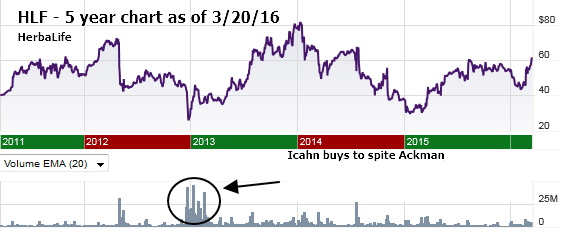
The chart above highlights the time frame where Ackman announced his short position and Icahn bought shares. It seems that Icahn bought somewhere below $39. If that’s the case, Icahn is sitting on at least a +70% profit in his HLF investment.
December 20, 2012 – Bill Ackman calls Herbalife a pyramid scheme in a three-hour presentation accompanied with a 334-page report. Stock opened at $35.82 and closed at $33.70. The previous day’s open was $42.73, so Ackman’s report basically led to tangible sell-off in HLF.
February 14, 2013 – Carl Icahn holds 12.98% stake in Herbalife. Price on the day’s close was $38.27 compared to previous day’s $36.40. Carl Icahn believes Bill Ackman is wrong about Herbalife, and the company’s stock becomes the metaphorical boxing ring for the two hedge fund titans to settle their differences.
The Turning Point Is At Hand
At this point, it may be too early to short Herbalife convincingly unless one is willing to wait for an extended period of time for the company to turn. At the same time, it would be unwise to buy Herbalife right now, because of market valuation being above fair value respective to normalized future cash flows.
In the long term, I believe the turning point is at hand. I do not see a scenario where Herbalife continues to increase revenue over the long term by simply recruiting direct sellers to sell a variety of shake powders. Therefore, I do not see Herbalife being around in its current form within the next 10 years.
Personal Predictions
- Expect to see U.S. sales diminish greatly within the next five years.
- Expect China to tighten up regulations on Herbalife.
- Expect Carl Icahn to begin selling his stake in Herbalife at a whopping +70% profit, as he did with Apple due his worries about China. (According to Icahn, his average holding period is 7 years but held Apple stock for approximately 3 years. He has held Herbalife for over 3 years and it will be four years if he holds into January 2017.)
Quick Bull Case / Quick Rebuttal
Bull: There must be a short squeeze due to Bill Ackman covering his short.
Bear: We see the opposite – Icahn unwinding his positions to take profit.
Bull: U.S. is only 22.18% of Herbalife’s sales.
Bear: That is a significant amount, and China comprises another 20.18% which also holds a lot of uncertainty.
Bull: Herbalife’s injunction in the U.S. banning manipulative recruiting practices does not apply overseas, where 78% of its revenue is still being generated.
Bear: Yes, but for how long can that last before people in those countries also realize that they too cannot make any money selling Herbalife? There will be a tipping point, just like in the United States, and regulations will be made. Time is on the side of the bears, not the bulls.
Bull: Carl Icahn holds a sizable long position.
Bear: Carl Icahn held a sizable position in Apple, too, and he bailed out when he became worried about China. Herbalife might be Carl Icahn’s next Apple.
Conclusion
Although I expect Herbalife to maintain positive gross profits for the near-term, it is very difficult to see a scenario where direct-selling a variety of nutritional shake powders can maintain profitability in the long term when the accounting of revenues were flawed and must now be changed.
In the past, distributors purchasing products for sale counted as revenue so the actual consumer demand for Herbalife’s products is unclear. Moving forward, that is no longer the case in the United States. Although distributors purchasing products for sale will still be counted as revenue, it will be accounted for separately, which will give a very transparent view of Herbalife’s real product demand.
It is also not out of the question that regulators from other countries may also clamp down on Herbalife’s business model and accounting practices. In fact, Herbalife may even choose to willingly implement those accounting changes overseas as a preemptive maneuver to keep regulators off their backs and buy themselves time while preserving cash.
Although I would not consider a short position in Herbalife stock a no-brainer, I consider being bearish at this time a better position than a bullish one, mostly because current price is above my personal fair value appraisal of HLF’s underlying business.
Article Source: SeekingAlpha.com

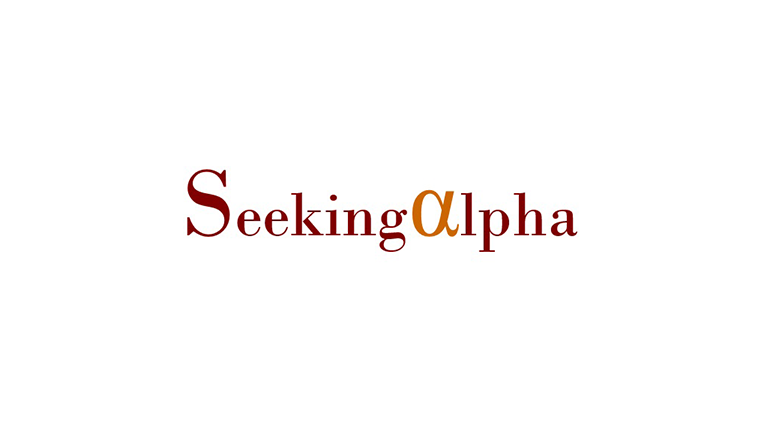
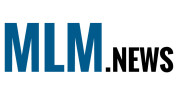
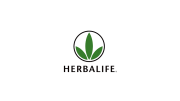
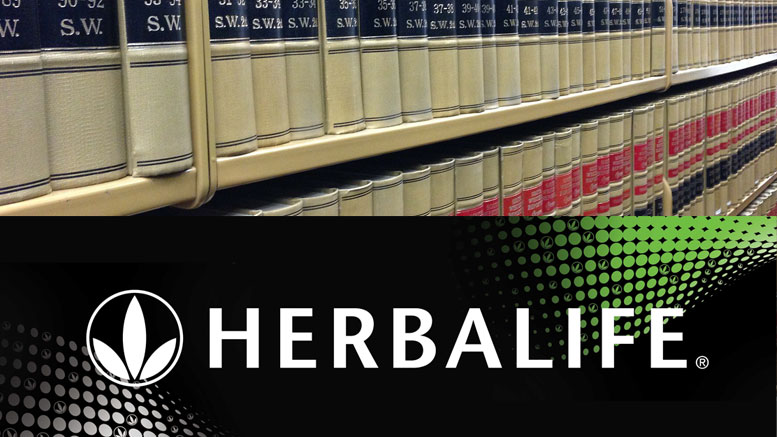
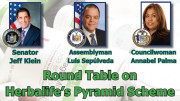
Be the first to comment on "Herbalife: Still Profitable"